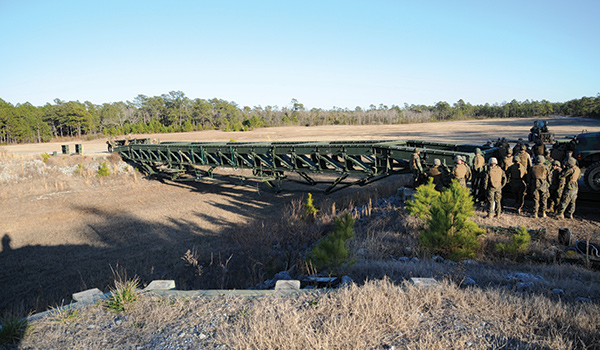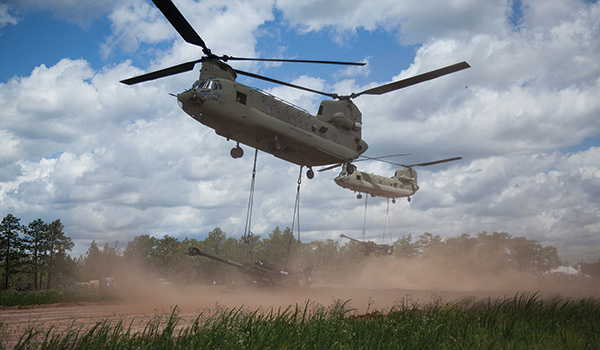
Rotary Wing PM / COL Greg Fortier, LTC John Schmitt, and MAJ Shawn Naigle: In late September 1944, Operation Market Garden began with Allied paratroopers attempting to seize several bridges and secure a Rhein River crossing into Germany. While historians debate the success of the operation, the importance of controlling bridges across river obstacles in maneuver warfare is undeniable. Armies throughout history have used rivers as natural defensive obstacles or targeted them as key terrain for supply line interdiction; both techniques aimed to constrain the opposing forces on freedom of maneuver. Rapid bridge emplacements utilizing engineer bridging units are an attempt to offset mobility restrictions. However, history has demonstrated the bridgeheads are at their most vulnerable early in the operation, which is why it is important to mass combat power to protect the bridgehead. Failure to do so increases vulnerability during the early stages of operations, thereby providing the enemy an opportunity to react while increasing operational risk.

U.S. Navy Seabees and Marines work together to assemble a Medium Girder Bridge (MGB) during a joint training exercise at Camp LeJeune, NC. / U.S. NAVY PHOTO BY CHIEF MASS COMMUNICATION SPECIALIST SCOTT B. BOYLE
Fast forward eighty years to 2024 where a similar operation is underway to gain mobility across a river in Eastern Europe or North Korea. Somewhere far outside of artillery range, two companies of twelve CH‑47F Block II Chinooks prepare to support a bridging operation. As night falls, a platoon of the next generation Chinook lifts four 18,000-pound, fully assembled, medium girder bridge sections to a lightly defended river crossing location 65 miles away. The cockpit interface and advanced communications heightens crew situational awareness while an upgraded Digital Advanced Flight Control System enables a supervised autonomy flight mode to emplace the load within one foot of the mission essential location. Simultaneously, the remainder of the CH‑47F Block II Chinooks deploys a company of combat loaded Joint Light Tactical Vehicles (JLTV) and a battery of M-777 towed artillery with its primary mover, crew, and a full complement of ammunition for bridgehead security. The aircraft survivability, cyber hardness, and countermeasure suite enable both Chinook companies to complete the mission without loss.
Within an hour of the first Chinook’s departure, the mobility restriction associated with the river evaporates. In comparison to the antiquated and vulnerable pre-staged combat engineer bridging units of old, the speed and unpredictable location of the aerial emplaced bridge offers game-changing mobility to ground commanders. Only the CH‑47F Block II Chinook can lift the medium girder bridge, JLTV, and M-777 as configured in this scenario without trading aircraft survivability or mission equipment for payload.
Block II Capabilities
Although future conflicts are difficult to predict and this is only one scenario, the CH‑47F Block II Chinook is designed to deliver increased capability to ground commanders regardless of the mission. From the strengthened airframe to the improved drive train, each subsystem upgrade in the CH‑47F Block II program contributes towards the payload increase over currently fielded CH-47F Block I aircraft; all while drastically improving aircraft readiness.

U.S. Army CH-47 Chinooks assigned to the 82nd Airborne Division haul M777A2 Howitzers assigned to 1st Battalion, 319th Airborne Field Artillery Regiment during the Airborne Review as part of All American Week 100 at Fort Bragg, N.C., May 25, 2017.
Specifically, the CH‑47F Block II features reinforced key structural components to enable continuous operation at a maximum gross takeoff weight of 54,000 pounds. To compliment and realize the target gross weight increase, the CH‑47F Block II program will qualify the current CH‑47F drive train to accept 10% additional power. The additional torque is essential to increasing performance in operating conditions where the current CH‑47F is transmission limited.
The new Advanced Chinook Rotor Blade (ACRB) efficiently augments payload performance by reducing power required to hover, which translates to increased lift or decreased fuel consumption at a hover. The ACRB is particularly effective at high hot conditions where engine power limits performance. When combined with the 500 pounds of additional fuel capacity in the CH‑47F Block II lightweight fuel system, the next generation Chinook can externally transport a combat equipped JLTV to a 110-mile radius.
Additional modifications leave room for future subsystem and countermeasure growth and include a structural foundation for a future engine. The CH‑47F Block II is the fusion of conscious payload, range, and power efficiency decisions to enable the full range of mission execution.
Whether it is assured mobility, extended operational reach, or simply delivering combat power to ground commanders, the return on the CH‑47F Block II investment for future combat operations is exponential. The first prototype aircraft will begin flight test in the summer of 2019 with first unit delivered in 2024. Meanwhile, the Cargo Helicopter Program Management Office continues to actively pursue methods to deliver faster without risking safety or quality.
Regardless of operational name or campaign, the crucible of ground combat remains unforgiving. The need to mass combat power at the decisive point of an operation while retaining freedom of maneuver is essential. The CH-47F Block II will represent the adaptive heavy lift capability within the evolving multi-domain battlespace.
COL Greg Fortier is the project manager of the CH-47 Cargo Helicopter Project Office; LTC John M. Schmitt is the product manager and MAJ Shawn C. Naigle is the assistant product manager of the CH-47F Modernization Product Office, Cargo Helicopter Project Office; all located at Redstone Arsenal, AL.
U.S. Navy Seabees and Marines work together to assemble a Medium Girder Bridge (MGB) during a joint training exercise at Camp LeJeune, NC. / U.S. NAVY PHOTO BY CHIEF MASS COMMUNICATION SPECIALIST SCOTT B. BOYLE








